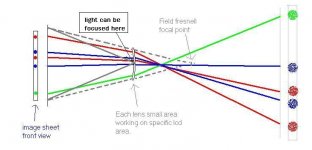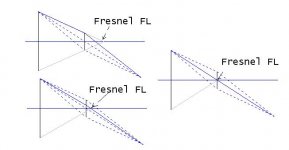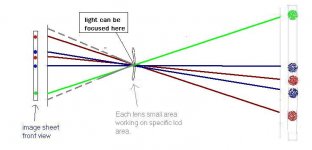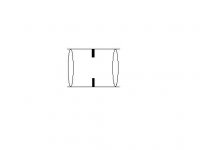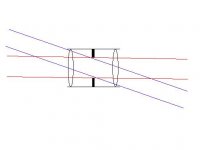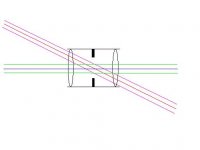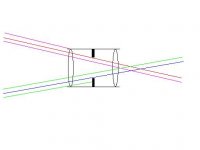Dazzla, do you understand the post 39?
about the small lens area working on exclusive lcd area, and that it never hapens on crt?
thanks for your replys i´m enjoiyng very much this thread. 😀
about the small lens area working on exclusive lcd area, and that it never hapens on crt?
thanks for your replys i´m enjoiyng very much this thread. 😀
please now draw the light rays on top of your image, focusing at center. Would like to know what happens to the projected image in your setup.
Dazzla, do you understand the post 39?
Yes and that is the reason why with perfect point source and perfect condenser and field lens it could theoretically be possible to project with out the objective lens. Think of the light leaving each pixel as being collimated or close to it, like a laser beam. You could even remove the field and collector lenses as well, the image size would be determined by the point source position.
DJ
please now draw the light rays on top of your image, focusing at center. Would like to know what happens to the projected image in your setup.
Here is a pic showing decreasing fresnel FL. The solid blue line is the actual light ray that is coming from the LCD. The dotted blue lines are just there to show what the lens is capable of imaging and to find the correct refraction angles. In all of these the final image size is the same and the throw is the same. It just shows that at each different fresnel FL, less and less of the objective is being used.
DJ
Attachments
i mean that would like you to post a pic on the 39 post image showing the light rays for that image but focusing at center as you would do.
anyway, in your ideal setup, the projection lens is "optional"?
any focal and any diameter singlet lens will do the same work, (mean same work=nothing at all). So i don´t understand why you start the ideal design from 1/F=1/dist + 1/trhow
anyway, in your ideal setup, the projection lens is "optional"?
any focal and any diameter singlet lens will do the same work, (mean same work=nothing at all). So i don´t understand why you start the ideal design from 1/F=1/dist + 1/trhow
anyway, in your ideal setup, the projection lens is "optional"?
any focal and any diameter singlet lens will do the same work, (mean same work=nothing at all). So i don´t understand why you start the ideal design from 1/F=1/dist + 1/trhow
Because it is a theoretical starting point.
i mean that would like you to post a pic on the 39 post image showing the light rays for that image but focusing at center as you would do.
Attachments
ok i agree with the light rays.
but now "each lens small area working on specific lcd area" is not true. just the central small area is working, rest of lens is out of work. And even the central area does nothing to the rays because it is the lens teory.
you don´t need to start from 1/F=1/Dist + 1/throw if you are not going to use a projection lens. You can have any throw and any desired image size at any throw. Just need to choice the needed focal lengh field fresnell; pinhole, you know.
My setup includes a projection lens, so i need to start from there, my parameters are the throw, rear lens aperture, lcd size... so only one setup is the optimal.
What i am triyng to do with all this thread is find a perfect world ideal setup and then introduce there step by step some real world imperfections (arc lengh, triplet (non thin) projection lens...)
so i can design real world optimal setup. So i can work out the ideal real world field frenell lens focal.
Actually i found your optical center focusing setup erroneus, but can´t show it anyway. 😀 (i would be a bad teacher 😀) anyway, in the triplet 135 case, focusing at optical center and focusing at rear lens element full aperture (what i would do) is close somehow and isn´t to much difference for the field fresnell lens and 17" lcd. But i don´t like to telling jinhuan (is it ok? i don´t remenber the 3dlens owner name) that 550 is ideal. I found it something short. It´s a shame for me not to make you understand why. Anyway, it is much better than actual 330 no doubt of it.
thanks for your replys. Rox
but now "each lens small area working on specific lcd area" is not true. just the central small area is working, rest of lens is out of work. And even the central area does nothing to the rays because it is the lens teory.
you don´t need to start from 1/F=1/Dist + 1/throw if you are not going to use a projection lens. You can have any throw and any desired image size at any throw. Just need to choice the needed focal lengh field fresnell; pinhole, you know.
My setup includes a projection lens, so i need to start from there, my parameters are the throw, rear lens aperture, lcd size... so only one setup is the optimal.
What i am triyng to do with all this thread is find a perfect world ideal setup and then introduce there step by step some real world imperfections (arc lengh, triplet (non thin) projection lens...)
so i can design real world optimal setup. So i can work out the ideal real world field frenell lens focal.
Actually i found your optical center focusing setup erroneus, but can´t show it anyway. 😀 (i would be a bad teacher 😀) anyway, in the triplet 135 case, focusing at optical center and focusing at rear lens element full aperture (what i would do) is close somehow and isn´t to much difference for the field fresnell lens and 17" lcd. But i don´t like to telling jinhuan (is it ok? i don´t remenber the 3dlens owner name) that 550 is ideal. I found it something short. It´s a shame for me not to make you understand why. Anyway, it is much better than actual 330 no doubt of it.
thanks for your replys. Rox
Rox there is nothing wrong with the way you are working out the fresnel FL using the full aperture being lit. As long as you take into account the size of the lamp arc and other distortions.
DJ
DJ
ok, then why should we tell to 3dlens it is 550mm the best one?
would like Guy Grotke to share ideas as well, since he was who said it to 3dlens.
would like Guy Grotke to share ideas as well, since he was who said it to 3dlens.
Sorry to interupt you Rox, but this could help us both understand. But my question is for Dazzla or Guy.
Lets say I want to set up a projector using a 17"lcd, 450mm 200mm diameter triplet (like the one sold at diyprojectorcompany.com). I want to project an image on a screen 13feet from the projector triplet. My arc light length is 25mm. What would be the "ideal" vs. "best" options for both rear and front fresnels, and how far would the triplet have to be placed from the front fresnel to produce a sharp image.
I would really appreciate your time in calculating this for me. I am still in the dark for how these calculations work...even though I did read the whole thread.
Lets say I want to set up a projector using a 17"lcd, 450mm 200mm diameter triplet (like the one sold at diyprojectorcompany.com). I want to project an image on a screen 13feet from the projector triplet. My arc light length is 25mm. What would be the "ideal" vs. "best" options for both rear and front fresnels, and how far would the triplet have to be placed from the front fresnel to produce a sharp image.
I would really appreciate your time in calculating this for me. I am still in the dark for how these calculations work...even though I did read the whole thread.
you are welcome jdevo2004.
i understand perfectly what they do, the only problem is that i don´t agree with them. So we are discussing friendly.
about your 450 focal triplet, are you sure you mean 200mm aperture? it is not the one sold by DBG/DYLABS, the famous one is 135 triplet, 130mm clear aperture.
Hope GG/Dazzla would help you.
i understand perfectly what they do, the only problem is that i don´t agree with them. So we are discussing friendly.
about your 450 focal triplet, are you sure you mean 200mm aperture? it is not the one sold by DBG/DYLABS, the famous one is 135 triplet, 130mm clear aperture.
Hope GG/Dazzla would help you.
Why the optical center is better
This is a drawing of a symmetric duplet projection lens, commonly used in overhead projectors. It has two positive lenses and a stop aperature at the optical center of the lens. The aperature makes the image sent to the sides and corners of the screen have the same amount of light as the image sent to the center, when the light is coming from a diffuse object. Triplets have almost the same design, but the aperature is replaced by a small negative lens.
This is a drawing of a symmetric duplet projection lens, commonly used in overhead projectors. It has two positive lenses and a stop aperature at the optical center of the lens. The aperature makes the image sent to the sides and corners of the screen have the same amount of light as the image sent to the center, when the light is coming from a diffuse object. Triplets have almost the same design, but the aperature is replaced by a small negative lens.
Attachments
more
This drawing shows the paths of light going through the duplet. You can see how the aperature lets through the same amount of light for each path. Without the aperature, much more light would follow the straight-through path so the center of the screen image would be much brighter than the edges.
This drawing shows the paths of light going through the duplet. You can see how the aperature lets through the same amount of light for each path. Without the aperature, much more light would follow the straight-through path so the center of the screen image would be much brighter than the edges.
Attachments
more
This drawing shows the paths of light going through the duplet in an LCD projector when the fresnels focus the arc image at the optical center of the lens. The red line shows the ray coming from the center of the lamp arc, while the magenta lines show the rays coming from the ends of the lamp arc and going through the same LCD pixel.
The blue line shows the ray coming from the center of the lamp arc through the center pixel, while the green lines show the rays coming from the ends of the lamp arc and going through that same pixel.
The area in the middle of the lens defined by the intersection of all the rays contains the image of the lamp arc projected by the fresnels. If you removed the projection lens and replaced it with a piece of white paper, you would see an image of the lamp arc. The size of that projected lamp arc image is a product of the arc length and the fresnels distances:
image size = arc length * (field fresnel to arc image) / (arc to condensor fresnel)
(This assumes an non-split design.) So with a lamp arc length of 24 mm, a 220 mm fl condensor fresnel, and a 550 mm fo field fresnel, the arc image would be 60 mm across.
This drawing shows the paths of light going through the duplet in an LCD projector when the fresnels focus the arc image at the optical center of the lens. The red line shows the ray coming from the center of the lamp arc, while the magenta lines show the rays coming from the ends of the lamp arc and going through the same LCD pixel.
The blue line shows the ray coming from the center of the lamp arc through the center pixel, while the green lines show the rays coming from the ends of the lamp arc and going through that same pixel.
The area in the middle of the lens defined by the intersection of all the rays contains the image of the lamp arc projected by the fresnels. If you removed the projection lens and replaced it with a piece of white paper, you would see an image of the lamp arc. The size of that projected lamp arc image is a product of the arc length and the fresnels distances:
image size = arc length * (field fresnel to arc image) / (arc to condensor fresnel)
(This assumes an non-split design.) So with a lamp arc length of 24 mm, a 220 mm fl condensor fresnel, and a 550 mm fo field fresnel, the arc image would be 60 mm across.
Attachments
more
This drawing shows the paths of light going through the duplet in an LCD projector when the fresnels focus the arc image past the optical center of the lens. The red line shows the ray coming from the center of the lamp arc, while the magenta lines show the rays coming from the ends of the lamp arc and going through the same LCD pixel. Half of the light through that pixel does not get through the lens,
The blue line shows the ray coming from the center of the lamp arc through another corner pixel, while the green lines show the rays coming from the ends of the lamp arc and going through that same pixel. Again, half of the light through that pixel does not get through the lens.
All of the light from a central pixel will get through the lens, so the corners of the image will be much dimmer than the center. Notice also that the maximum field angle is reduced compared to the case where the arc image is focussed at the optical center of the projection lens. The only way to compensate for these problems is to use a much larger diameter projection lens. Then the fresnels can focus the arc image past the lens without any dim corner problems. Instead, the lens will be much more expensive and the final image may be more affected by spherical aberration and barrel distortion that get worse near the edges of a large diameter spherical lens.
This drawing shows the paths of light going through the duplet in an LCD projector when the fresnels focus the arc image past the optical center of the lens. The red line shows the ray coming from the center of the lamp arc, while the magenta lines show the rays coming from the ends of the lamp arc and going through the same LCD pixel. Half of the light through that pixel does not get through the lens,
The blue line shows the ray coming from the center of the lamp arc through another corner pixel, while the green lines show the rays coming from the ends of the lamp arc and going through that same pixel. Again, half of the light through that pixel does not get through the lens.
All of the light from a central pixel will get through the lens, so the corners of the image will be much dimmer than the center. Notice also that the maximum field angle is reduced compared to the case where the arc image is focussed at the optical center of the projection lens. The only way to compensate for these problems is to use a much larger diameter projection lens. Then the fresnels can focus the arc image past the lens without any dim corner problems. Instead, the lens will be much more expensive and the final image may be more affected by spherical aberration and barrel distortion that get worse near the edges of a large diameter spherical lens.
Attachments
OK, in your duplet, when you focus the light at the optical center, you are filling the rear lens aperture perfectly. This is exactly what i was triyng to say.
You said as well that if larger aperture lens is used, it is posible to focus farther with the field lens. I agree
If you draw those same pics with the 135 triplet, and you focus at the center of the lens, some part of the rear lens will never be hit with the light from the lcd.
I guess that ideal fresnell lens told to 3dlens is not a duplet lens based fresnell but a 135 famous triplet. Anyway, what assumtions did you take as well (100" image? 17" lcd?....) i just would like to see the standar setup.
why do you say "spherical aberration and barrel distortion" they are minimized on triplets, nothing to do with douplets. I think that if there are singlet based OHP (most of what i have seen at school), triplets have to be terrific.
fresnell + triplet = better image quality than crt + triplet do you agree?
You said as well that if larger aperture lens is used, it is posible to focus farther with the field lens. I agree
If you draw those same pics with the 135 triplet, and you focus at the center of the lens, some part of the rear lens will never be hit with the light from the lcd.
I guess that ideal fresnell lens told to 3dlens is not a duplet lens based fresnell but a 135 famous triplet. Anyway, what assumtions did you take as well (100" image? 17" lcd?....) i just would like to see the standar setup.
why do you say "spherical aberration and barrel distortion" they are minimized on triplets, nothing to do with douplets. I think that if there are singlet based OHP (most of what i have seen at school), triplets have to be terrific.
fresnell + triplet = better image quality than crt + triplet do you agree?
sorry, forgot to mention the relation between fresnell an lcd size.
if you had the same duplet but smaller lcd (7" istead 15") would you still use the same field lens focal? So would you still focus at center of doublet?
if you had the same duplet but smaller lcd (7" istead 15") would you still use the same field lens focal? So would you still focus at center of doublet?
Sorry, i wouldn´t like to create a confusion, iám saying that i would focus the lamp farther than the optical center, yes but this is not the key of what i am triyng to say;
I mean we should focus the lamp where focusing does fill the rear lens aperture fully so there is no light outside and is not any part of lens not being hit by light. This way, it could happen that we need to focus farther than optical center or before the optical center. It all depends on the lcd size, lens dimensions....
if we do try to fill 135 triplet this way, we found 550 is to short.
but would like to check the assumtions GG took, to do the same setup, so tell me them please.
(it was something like 100", 17"lcd, 135triplet, 220rear fres, 20mm fres-lcd dist, unsplit.... something is wrong/left?)
I mean we should focus the lamp where focusing does fill the rear lens aperture fully so there is no light outside and is not any part of lens not being hit by light. This way, it could happen that we need to focus farther than optical center or before the optical center. It all depends on the lcd size, lens dimensions....
if we do try to fill 135 triplet this way, we found 550 is to short.
but would like to check the assumtions GG took, to do the same setup, so tell me them please.
(it was something like 100", 17"lcd, 135triplet, 220rear fres, 20mm fres-lcd dist, unsplit.... something is wrong/left?)
My design parameters
I assumed a 17" LCD, a 450 mm fl projection lens, and throw distances of 10', 12', and 14'. I also assumed a non-split design with the fresnels a minimum of 20 mm from the LCD. (Some of those throw distances would use more than 20 mm spacing.)
The condensor fresnel focal length does not matter: My design assumes you put the lamp at the focal length distance from the condensor fresnel, so the rays entering the field fresnel are parallel.
But of course, that is not absolutely necessary: You could make a field fresnel with a focal length of anywhere in the 450 mm to 700 mm range work reasonably well by adjusting the distance between the lamp arc and the condensor fresnel.
Rox, I think everyone reading this thread understands what you mean when you explain about filling the first lens surface of the triplet with light. But we see nothing positive and many negative effects from doing that. So far both sides of this discussion are theoretical. It would be very good if someone who actually has one of the 450 mm fl triplets would run some experiments!
I would like to see some spot size and lux measurements at the center and the corners of the screen, with the arc image focussed at the optical center of the triplet and then at ancreased distances past the center. I believe the spot sizes will get larger and the difference between the center and corner lux values will get larger as the focussed arc image moves farther away from the center of the triplet. But there is no good substitute for running a real experiment.
I assumed a 17" LCD, a 450 mm fl projection lens, and throw distances of 10', 12', and 14'. I also assumed a non-split design with the fresnels a minimum of 20 mm from the LCD. (Some of those throw distances would use more than 20 mm spacing.)
The condensor fresnel focal length does not matter: My design assumes you put the lamp at the focal length distance from the condensor fresnel, so the rays entering the field fresnel are parallel.
But of course, that is not absolutely necessary: You could make a field fresnel with a focal length of anywhere in the 450 mm to 700 mm range work reasonably well by adjusting the distance between the lamp arc and the condensor fresnel.
Rox, I think everyone reading this thread understands what you mean when you explain about filling the first lens surface of the triplet with light. But we see nothing positive and many negative effects from doing that. So far both sides of this discussion are theoretical. It would be very good if someone who actually has one of the 450 mm fl triplets would run some experiments!
I would like to see some spot size and lux measurements at the center and the corners of the screen, with the arc image focussed at the optical center of the triplet and then at ancreased distances past the center. I believe the spot sizes will get larger and the difference between the center and corner lux values will get larger as the focussed arc image moves farther away from the center of the triplet. But there is no good substitute for running a real experiment.
- Status
- Not open for further replies.
- Home
- General Interest
- Everything Else
- The Moving Image
- Optics
- guy grotke question
